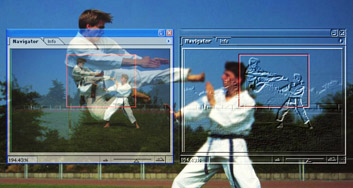multiblending
|
up patrick baudisch |
| multiblending publications (CHI'04) |

|
Alpha blending vs.
multiblending at the example of palette windows over an image
editing application. Left: With traditional alpha blending this overview palette blurs together with the photo in the background. Users cannot tell anymore which of the bushes are part of the palette and which are part of the photograph. Right: With multiblending (here a design called "glass palettes") palette and background are clearly distinguishable. All visible edges belong to the palette; all color information belongs to the background. This glass palette design involves desaturating and embossing the palette and blurring the background. See the entire application with alpha and multiblending. |
Alpha blending allows the simultaneous display of overlapping windows—such as palette windows in visual workspaces. Although alpha blending has been used in some applications, such as games, it has not been widely adopted. One reason for the limited acceptance is that in many scenarios, alpha blending compromises the readability of content. We introduce a new blending mechanism called multiblending that uses a vector of blending weights, one for each class of features, rather than a single transparency value. Multiblending can in most cases be automatically optimized to preserve the most relevant features of both the palette and the background window. In our user study, multiblended palettes provided higher recognizability of both the background and the palette than the best participating version of alpha blending.